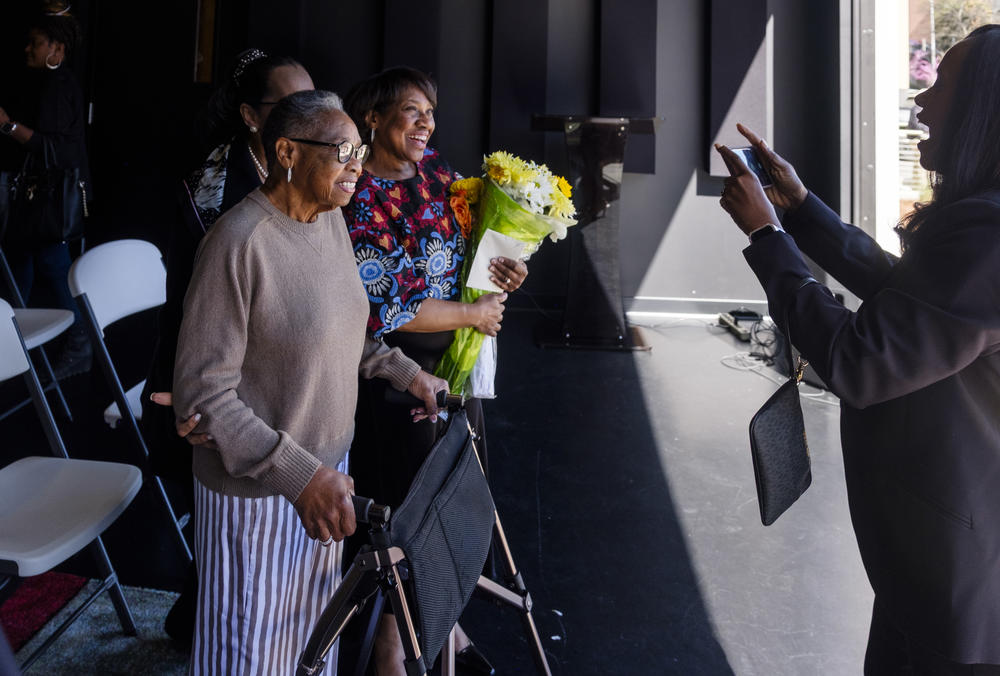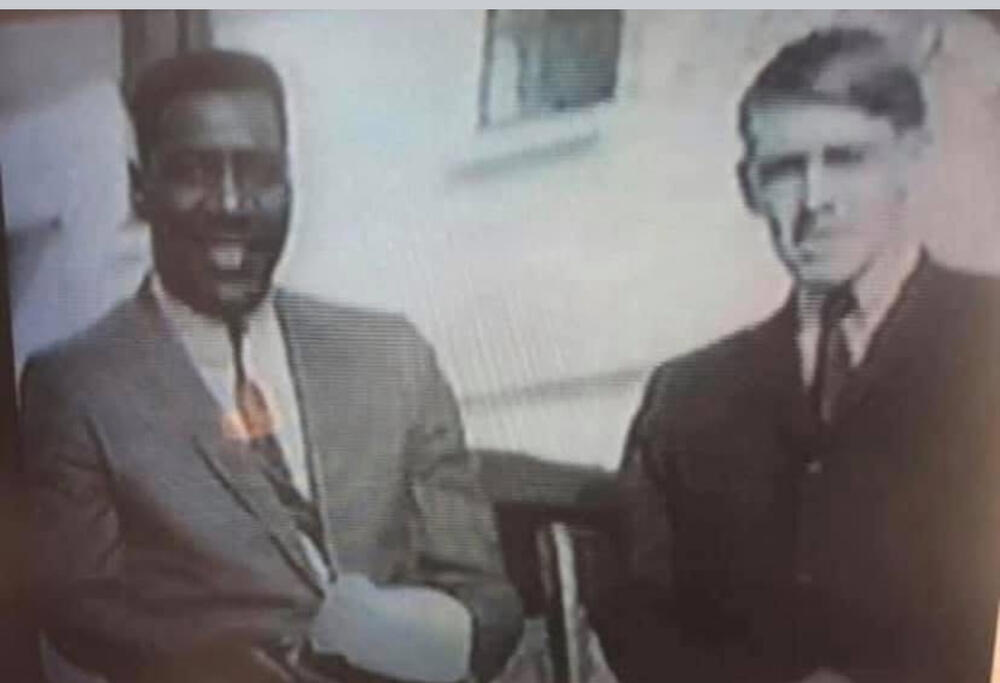
Caption
A crowd gathered in the Zelma Redding Amphitheater for the official opening March 18, 2025, of the Otis Redding Center for the Arts in Macon, Ga.
Credit: Grant Blankenship/GPB News
“He stays on my mind constantly, I think about him all the damn time.” - Alan Walden

A crowd gathered in the Zelma Redding Amphitheater for the official opening March 18, 2025, of the Otis Redding Center for the Arts in Macon, Ga.
In the last few days of March, the Estate of Otis Redding marked the 60th Anniversary of Otis Redding’s album, “The Great Otis Redding Sings Soul Ballads.”
Late March 1965, the release of the Terrell County legend’s second studio work, illustrating his remarkable talent, and establishing one of the greatest albums in music history.
The grand opening of the Otis Redding Center for the Arts (Orca) was held March 18th in Macon. The new facility will serve children between 5-18 thoughts the arts and musical education.
A bronze statue honoring Mr. Redding will be debuted in the weeks ahead as part of the Zelma Redding Amphitheater center campus.

Zelma Redding (left), widow of Otis Redding, and her daughter Karla Redding-Andrews pose for a photo after the ribbon-cutting at Macon's Otis Redding Center for the Arts on March 18, 2025.
RELATED: The new arts center named for soul great Otis Redding is open for education and expression
It is impossible not to think, what if he had lived?

Otis Redding performing
58 years ago, a remarkable life came to an end in a frozen Wisconsin lake.
December 10th, 1967, Otis Redding was a passenger riding in a twin engine plane heading to Madison, Wisconsin after departing Cleveland.
Although the weather was poor, with heavy rain and fog, and despite warnings, the plane took off and crashed. 7 fatalities including 26 year old Otis Redding. The cause of the crash was never determined.
Atlanta, Macon, and the state of Georgia was stunned.
“When I first heard it, I jerked the phone out of the wall, I mean—it was No! No! No! It was the roughest night of my life,” said Alan Walden from his home in middle Georgia.

Otis Redding and Alan Walden, his manager and friend.
Macon’s legendary Walden brothers, Phil (1940-2006) and Alan (b 1943), handled the career of Otis Redding and 44 other African American recording artists, breaking racial barriers in the South and the country.
“I immediately headed for the Redding’s Round Oak Ranch (300 acres in Jones County) to comfort Zelma (the wife of Otis Redding).
Mr. Walden told me the Dawson, Georgia native (Terrell County) had recorded a song, a few days earlier, no one wanted him to sing.
“Otis said this is going to be my first million seller. He liked it right away. It would be aimed at the pop market, the whistling was a risk, a change. How would his black audience feel about this unusual song? Otis had it right—as usual,” said Mr. Walden.

Otis Redding performing in front of a large crowd.
“The song was a monster, (Sittin on) Dock of the Bay became one of the greatest hits in the annals of American music and it became the first #1 posthumous hit too.”
The luminous Mr. Redding wrote and performed astonishing music—“Respect,” “Try a Little Tenderness,” “Mr. Pitiful,” and “These Arms of Mine.”
A seminal artist, the Redding influence never dimmed by time, a fast intellect, he had his pilots license, loved horses and was an excellent outdoorsman, skilled in hunting and fishing.
When the Beatles were asked in 1965 their biggest influence, John Lennon responded, “Otis Redding.”
“He was my best friend, a fascinating person with a heart of gold, always genuine,” laments Mr. Walden.
Alan Walden was a sophomore at Mercer University in Macon when his older brother graduated from college and served in Germany as a lieutenant in the US Army.
“Phil was his manager and when he went in to the Army, he asked if I would step in and run his company until his return in 1965.”
Alan would team with Otis Redding.
The two men, one black, one white, bonded quickly in turbulent southern times.
When Mr. Redding moved around Georgia, Mr. Walden said, “I would move next door, we were neighbors.”
The synergy was surprising and effective.
“It took a lot from him to accept his manager’s little brother coming into to direct his career-----once he trusted me, the relationship was great. He (Otis) was such a genuine person, I believed everything he ever said, he was that kind of guy, you could confide with him in a way you couldn’t with other artists.”
This was a groundbreaking period in the southern soul music business, there were other great artists, and many would congregate in Atlanta inside the small building along the Sweet Auburn District, the Royal Peacock.
It was not unusual to see Percy Sledge, Ben E. King, Gladys Knight, Ray Charles, Marvin Gaye, Aretha Franklin, Bessie Smith, Louis Armstrong, B.B. King, Joe Louis, Little Richard, or the immortal Godfather himself, James Brown inside the club.
The Royal Peacock at 186 Auburn Avenue has a remarkable history dating back to 1937.

Royal Peacock on Auburn Avenue in Atlanta, Ga.
It was one of Americas best known clubs for African American star performers.
“We were in Atlanta quite a bit during this period, of course, The Royal Peacock was a destination, so was the Auditorium, and Fulton County Stadium.”
The new big sports stadium would host a 1965 soul show of R & B legends with a racially mixed audience of 25,000.
Mr. Walden remembers vividly, “We played there with James Brown and 6 other acts—Joe Tex, Wilson Pickett, and Otis, It was a great show, successful gig, made lots of money. Otis was nervous, James (Brown) asked him to cut his performing time, Otis wanted to please James and not make an enemy, he was concerned about how it would go, as he walked out on stage, the white kids had rolled out a banner---Welcome Home Big O.”
Otis Redding would tour Europe along with his manager and friend Alan Walden.
Mr. Redding playing all the major concert venues of the time.
“We were #1 in Europe then, Otis was determined to be #1 in the United States too, he was #2 behind James Brown, and was trying to knock off the Godfather --- things were coming together for us everywhere.”
Otis Redding was just beginning to hit his stride.
The 1967 Monterrey Pop Festival in California was a springboard to crossover.
And with great success came opportunity.

Tom Jones, Phil Walden, Otis Redding and others during his European Tour.
“He had two movie scripts on his desk at the time of the plane crash. They (Hollywood) wanted him to act, he could have made it, whatever he did , he did well. Otis was terrific keeping everything organized and in order—writer, producer, musician, publisher, rancher, husband, friend, he wore many hats well.”
Otis Redding’s brilliance was like a nova in 1967.
Possibilities for the new year seemed limitless.
Two weeks before Christmas, an aviation disaster ended the Redding dream.
“I still to this day cry over Otis Redding. Every now and then, I’ll see a picture or hear his song that reminds me of him and our time—that time,” Mr. Walden pauses then starts again, “ He stays on my mind constantly----I think about him all the DAMN time.”